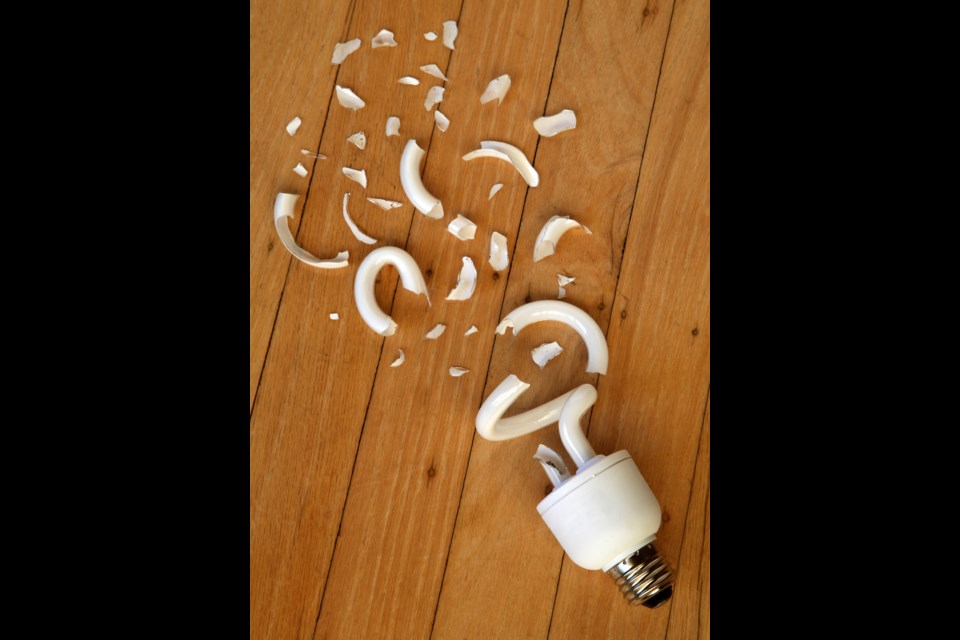The warm glow of a candle still has its appeal, but the convenience of the light bulb makes it unlikely to disappear anytime soon. That said, no bulb lasts forever, and when they inevitably go out, they can be recycled.
Not all light bulbs, however, are created equal. Mercury-containing bulbs common to most households require special considerations. Is your household managing its light bulbs safely?
Most homes these days are lit up by long-lasting LED (light-emitting diode) and the compact version of age-old fluorescent tubes, CFLs, which fit into a light bulb socket. Despite their often similar appearances, LEDs are more energy efficient, longer lasting and, as it turns out, easier to manage at the end of their life.
Until recent years, incandescent bulbs were commonplace. These bulbs create light by heating an internal filament until it glows.
Fluorescents, be they CFLs or the older style standard tubes, are low-pressure tubes filled with argon gas and mercury vapour. When electrified, they produce invisible ultraviolet (UV) rays that excite a fluorescent coating (phosphor) inside the tube, which emits the light you see.
Most of us are not aware that CFLs contain mercury, one of the World Health Organization’s top 10 chemicals of major public health concern. Exposure to mercury may have toxic effects on the nervous, digestive and immune systems as well as the lungs, kidneys and eyes, even in small amounts. For this reason, when a CFL bulb breaks, it is not simply an “oops” moment, but one that asks for swift and specific action.
When a CFL or fluorescent tube breaks, leave the room immediately, taking pets and people with you. Ventilate the room soon after and for 15 minutes prior to cleaning up. Don’t use a vacuum or broom for the initial clean up as these can stir up mercury vapour or dust and also become contaminated with them.
Instead, Health Canada recommends wearing disposable gloves and using a stiff piece of cardboard to sweep up the majority of the broken glass, disposing of it in a sealable and disposable glass container. For the finer clean up, use sticky tape or a disposable towel, adding these to the glass container or a sealed plastic bag.
If using a vacuum during this second phase, ensure good ventilation before, during and after, and then wipe down the vacuum and dispose of the vacuum bag in a sealed plastic bag immediately after. Wash your hands.
Remove the containers full of debris from your home and dispose of them quickly. They are not meant to be placed in curbside garbage as containers can be punctured or broken, releasing their toxic contents. Bring in a sealed container (you don’t mind losing) to any of the collection locations that collect light bulbs.
Considering these precautions, it’s prudent to store, handle and remove CFLs with a great deal of care. This care extends to the time they are dropped off at a location that takes them for recycling, as light bulbs are not accepted in curbside recycling.
Most municipalities have multiple drop-off points, which residents can locate using the Recyclopedia on the Recycling Council of BC’s website. In the qathet region, these include Rona, Augusta Recyclers, Town Centre Recycling Depot and Canadian Tire. Up to 16 bulbs and 16 tubes can be dropped off at any one time.
The care and disposal of light bulbs needs to be considered alongside their efficiencies. May this be an illuminating moment, taking all facets of lighting up your home into mind.
Let’s Talk Trash is contracted by qathet Regional District to deliver its waste reduction education program. For more information, email [email protected] or go to LetsTalkTrash.ca.
Join the Peak’s email list for the top headlines right in your inbox Monday to Friday.




